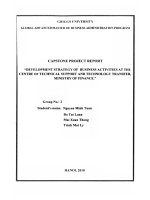Development strategy of national mental hospital 2
Bạn đang xem bản rút gọn của tài liệu. Xem và tải ngay bản đầy đủ của tài liệu tại đây (1.64 MB, 97 trang )
National Mental Hospital 2
GRIGGSUNIVERSITY
GLOBAL ADVANCED MASTER OF BUSINESS ADMINISTRATION PROGRAM
GRADUATION ASSIGNMENT
DEVELOPMENT STRATEGY OF
NATIONAL MENTAL HOSPITAL 2
PERIOD 2010 - 2015, VERSION 2020
Class:GaMBA01.C04
Group:08
Đao Nguyen Binh
Nguyen Van Kha
Vu Sy Phuong
Nguyen Trong Tuan
H
O CHI MINH
2011
Assignment of Strategy Management Group 8
GUARRANTEE
Our group of eight including four members undertakes that our group
researches graduation assignments of Master of Business Administration
Programmed of Griggs University.
Related theory and data in the main assignments were made by us and
references come partly from sources such as books, textbooks and other reference
materials in Vietnamese and English as well as from the magazines, internet The
actual data is collected directly in the National Mental Hospital 2.
From these data sources and basing on the approved outline, our group has
completed this assignment. Base the developing strategic solutions of the National
Mental Hospital 2 we introduce on studied theoretical basic as well as intuition and
members’ experience. In addition, it was through this assignment, members of
group have accumulated some valuable experience for the establishment of a
practical strategy for a hospital.
Assignment of Strategy Management Group 8
ACKNOWLEDGEMENT
Completing graduate assignment of Master of International Business
Administration Programmed - Griggs University after nearly a half year study, our
group eight sincerely gratitude to the MBA Program - Griggs University and
Training & Development Human Resource Center has created more favorable
conditions for us during the learning process, the group also would like to thank
most profoundly to the teachers who enthusiastically taught and imparted valuable
knowledge. We also wish to thank the teachers who guide our group to complete
this assignment.
In addition, the group would like to thank tutors for their enthusiasm to
support us. Thanking the leadership of the National Mental Hospital 2 for these
data, valuable information for this assignment.
Finally, we sincerely thank to the Director where we are working and all
members of the group for facilitate on the time as well as costs for us to complete
the course.
Please, accept our sincere and deep thanks.
Implementer
Group 8 - Class GaMBA01.C04
Assignment of Strategy Management Group 8
LIST OF ABBREVIATION
Matrix EFE External factor environment matrix
GDP Gross Domestic Product
Matrix IFE Internal factor environment matrix
Matrix QSPM Quantitative strategic planning matrix
S Strong
W Weak
O Opportunity
T Threat
MH Mental Hospital
MHC Mental Health care
TAS Total Attractiveness
AP Atlantic Philanthropies
VVF Viet Nam Veterans of America Foundation
RTCD Research and Training Centre for community Development
SD 1 Specialist Doctor 1
SD 2 Specialist Doctor 2
CPSD Center for Prevention Social Dies
CSIP Central of Social Illness Prevention
Great exercise of Strategic Management Group 8
Page1
TABLEOFCONTENTS
Reasons for choosing the topic 6
Research objectives 7
Object and scope of research study 8
Research Methodology 8
Significance of the topic 8
1.1. Overview of strategic management 10
1.1.1. The basic concepts of business strategy 11
1.1.2. Model of building a strategy 11
1.1.3. Tools for building and selecting strategy 14
1.1.3.4. Analysis of internal environment 17
1.1.3.5. Setting business Strategy 18
1.1.3.6. The solution to implement business strategies 18
1.1.3.7. Evaluate the effectiveness of business strategy 19
1.1.3.8.2. Internal factor matrix 20
1.1.3.8.3. SWOT Matrix 22
1.1.3.8.4. Quantitative strategic planning matrix (QSPM) 23
1.1.3.9. Strategic management in nonprofit organizations 25
1.2.Current status of the system of mental health care of some countries in the world
and Vietnam; difficulties and challenges 25
1.2.1. Developing countries 25
1.2.2. Developed countries 26
Great exercise of Strategic Management Group 8
Page2
1.2.3. The current status of the system of mental health care in Vietnam 26
1.2.4. Difficulties and challenges of mental health treatment system in Vietnam 27
1.3.Demand for strategic planning for the National Mental Hospital 2 28
1.3.1. The general tendency of mental health issues 28
1.3.2. Network of mental health care in southern provinces 29
1.4.The need to set out a develop strategy of the National Mental Hospital 2 29
2.The legal basis to build planning 31
2.1.Current situation of the National Mental Hospital 2 32
2.2.1. History and Development 32
2.2.2. Functions and responsibilities of the hospital 32
2.2.3. Functional divisions of the Hospital 38
2.2.4. Clinic departments 38
2.2.5. Subclinical departments 39
2.2.6. Scale of beds for patients 39
2.2.7. The situation of facilities and equipment 41
2.2.8. Situation of budget receipts and expenses 42
Figure II-7: Situation of budget receipts and expenses in 2010 43
2.3.The limits and causes 49
2.3.1. The limits 49
2.3.2. Causes 50
CHAPTER III 51
HOSPITAL DEVELOPMENT STATEGY BY 2020 51
Great exercise of Strategic Management Group 8
Page3
3.1.Development goals by 2020 51
3.1.1. Common goals 51
3.1.2. The goals to 2015 51
3.1.3. Target from 2015 – 2020 52
3.2.Analyzing internal-external environment. 52
3.2.1. Analyzing internal environment 53
3.2.2. Analyzing operation of the Hospital 60
3.2.3. The matrixes select the Hospital’s strategies 65
3.3.Strategy of the National Mental Hospital 2 in 2020 76
3.3.1. Predicted a number of patients from 2010 – 2020 76
3.3.2. Development strategy of expertise techniques 77
3.3.3. Development Strategy of Human Resource 80
3.3.4. Bed scale 80
3.3.5. Training staff 80
3.3.6. Science Research 81
3.3.7. International cooperation 81
3.3.8. Develop facilities, equipments 81
3.4.Solution – Proposal 82
3.4.1. Solutions 82
3.4.2. Proposal - Suggestion. 88
CONCLUSION 90
Great exercise of Strategic Management Group 8
Page4
LIST OF CHARTS
Chart I-1. Comprehensive strategic management model 14
Chart I-2. Strategic planning process 15
Chart I-3. Porter 5 competitive forces model 17
Chart I-4. Matrix of external factors 20
Chart I-5. Matrix of internal factors 21
Chart I-6. SWOT Matrix 22
Chart I-7. QSPM Matrix 24
Chart II-1. The National Mental Hospital 2 organizes free health examination and
medicines 36
Chart II-2. Daigram Presenting real bed scale against plan from 2005 - 2010 41
Chart II-3. Situation of budget receipts and expenses in 2010 43
Chart II-4. Receipt situation from the budget from 2005 -2010 44
Chart II-5. Budget structure to 2010 46
Chart II-6. The amount of patient examination and treatment from 2005- 2010 48
Chart II-7 Structure of in-patents and out-patents in 2010. 48
Great exercise of Strategic Management Group 8
Page5
LIST OF TABLES
Table II.1. Number of employees and staffs at the Hospital 37
Table II.2. Fluctuation in number of beds 40
Table II.3. Medical equipment of the Hospital 42
Table II.4. Budget revenue 43
Table II.5. Budget expenditure of the Hospital for the period 2005-2010 45
Table II.6. Budget revenue-expenditure balance for the period 2005-2010 46
Table II.7. Real situation of health examinations for the period 2005-2010 47
Table III.1. Matrix of external factors 65
Table III.2. Matrix of internal factors 66
Table III.3. SWOT Matrix 67
Table III.4. QSPM Matrix for S/O cooperative strategy group 71
Table III.5. QSPM Matrix for S/T cooperative strategy group 72
Table III.6. QSPM Matrix for W/O cooperative strategy group 73
Table III.7. QSPM Matrix for W/T cooperative strategy group 74
Table III.8. Forecasting number of patients for the period 2011-2020 by
extrapolation method 77
Table III.9. Human resource 81
Table III.10. Estimate capital requirement for the period 2011-2015 85
Table III.11. Estimate requirements of investment capital for the period 2011-2015
86
Table III.12. Estimate budget revenue for the period 2011-2015 86
Table III.13. Balance financial revenue and expenditure for the period 2011-2015
87
Great exercise of Strategic Management Group 8
Page6
INTRODUCTION
Reasons for choosing the topic
Health is a very important issue in improving the population quality; it is one
of human development strategies in every country around the world. According to
the World Health Organization, “Health is not just a non-disease
status, but a completely relaxed state in terms of physical, mental and social.” Being
healthy helps people work well and participate actively in economic,
social, community activities. So, to develop our country, we must first to pay
attention to health factors, make our people centered.
The great development of science technology entailing cultural changes has
affected spiritual relationships between people and people. Therefore, mental
health is becoming a more important issue in modern society.
According to the epidemiological survey in 2001 by mental
health professionals in Viet Nam, with only 10 common mental illnesses including
schizophrenia, depression, epilepsy, anxiety disorders, intellectual decline in the
elderly, psychotic after traumatic brain injury, delayed mental
development, mental disorders due to alcohol, behavior disorders in
adolescents, mental disorders due to drug, there has already been 14.9% of the
population suffered these diseases.
While the needs of people and society are increasing, our country’s medical
sector can not catch up with society's development, especially in improving
the quality of medical care in mental health field. To facilitate the medical care in
general and mental health care in particular and to meet the needs of
society, on February 23, 2005 Politburo issued Resolution 46-NQ-TW emphasizing
on the need of innovating and perfecting the health system towards equity,
efficiency and development.
Strengthening and perfecting the local health system in terms of facilities,
Great exercise of Strategic Management Group 8
Page7
equipment and personnel to create favorable conditions for all citizens to be
protected and improve their health with better quality, along with economic- social
development of the country. In particular, the
National Mental Hospital is the first Hospital in Dong Nai health sector which
implements Decree 43/CP of the Government and has been authorized to
be autonomy of finance by the Government as other revenue-generating hospitals.
On this basis, the Hospital has agreed with two goals and three solutions of the
Decree to change mindset: from service performer to service
providers. Such hospitals are viewed as a special enterprise, specializing in
providing guidance services, prevention and treatment of diseases related to mental;
financial resources are provided by the government and part of user
fees and other revenue sources. That is, Central Mental Hospital 2 should have the
appropriate financial solutions to develop and provide better medical services and
mental treatment satisfying the social needs
In that situation, the National Mental Hospital 2 needs to define a strategy for
the long-term activities to become a leading specialty hospital
in psychiatric industry in the South, with modern facilities and equipment and a
contingent of scientific and technical staffs on par with advanced countries in
the region. To contribute to realizing this goal, our group decided to do the research
project: “Strategy to develop National Mental Hospital 2 up to 2020”
Research objectives
The objectives of the research are:
- Summarizing theoretical basis of strategic planning;
- Analyzing and evaluating the activities of the National Mental Hospital 2
recently as well as the factors affecting the operation of the hospital;
- Comprehensively assessing the current operational situation of the
Great exercise of Strategic Management Group 8
Page8
National Mental Hospital 2 and the internal resources, from which we determine the
strengths and weaknesses;
- From the opportunities, challenges and strengths, weaknesses, proposing
business strategies in line with the situation of the National Mental Hospital 2;
- Propose some solutions and recommendations, to implement effectively the
proposed strategies.
Object and scope of research study
- Object: The National Mental Hospital in Dong Nai 2;
- The scope of research: Main activities in the National Mental Hospital 2.
Research Methodology
The research experiments the following methodologies:
- Using the method of dialectical materialism, historical materialism, the
description method, statistical analysis, synthesis, comparison, etc and apply
knowledge from several subjects in business administration major;
- Materials used: a textbook on business management, marketing management,
the documents of the National Mental Hospital 2, Department of Health, health
economics journal, The Sai Gon Economy, newspapers, year books and other
related magazines, the Internet, etc.
Significance of the topic
- Scientific significance:
3 In the market economy, business strategy is crucial to the success or
failure of the business. To survive and develop, first the enterprise needs to have
a good business strategy and performance;
3 There are many approaches to building a business strategy for any business.
The study has a scientific significance; that is, it has synthesized theories
Great exercise of Strategic Management Group 8
Page9
from various sources to build a business strategy in a most basic way, easy to
understand, easy to use.
- The practical meaning:
3 It is shown that in a developed society, people are increasingly under
pressure of study and work, environment is increasingly polluted by noise,
industrial waste, etc and therefore, more vulnerable to have
physiological illness, and mental illness are also more complex (The fact that the
paranoia, mental illness frequently happened for groups of students in recent
times has been a convincing proof for that).
3 National Mental Hospital 2 is the Hospital governed by the State, under the
direct management of the Ministry of Health, the research will analyze,
identify strengths and weaknesses of the hospital, and determine the challenges
in the present and future as a basis for the hospital leaders to plan development
strategy;
9 Research has provided National Mental Hospital 2 a source
of reference, quite well in quantifying the influence of these factors has and will
impact the business.
Great exercise of Strategic Management Group 8
Page10
CHAPTER I
THEORETICAL BASIS
1.1. Overview of strategic management
1.1.1. The basic concepts of business strategy
Concept of “strategy” appeared very early in the study of wars in the history.
The earliest definition of Strategy is seen as of the Greek historian Xenophon in the
6th century. Also in this period, Sun Tzu - a Chinese military theorist
also wrote “The Art of War” to discuss military strategy.
It is not until the middle of the 20th century, research of strategy and strategic
development really began. Scholars such as Drucker, Chandler,
Ansoff, Andrew and so on researched the development and great
success of economic groups in the United States before and during World War
2; and today’s administrators, economists as Michael E. Porter, Fred R. David,
Rudolf Grunig, Richard Kuhn and so forth have many different
approaches to strategic management in business. Here are a few different
definitions of strategy:
- “Strategy is the determination of goals, long-term fundamental purpose
of organization and the application of a sequence of actions as well as the
allocation of resources necessary to realize this objective” - Chandler (1962);
- “Strategy is the coordinative force between organizations and environment: a
consistent pattern of organizational decision chain in line with the environment” -
Mintzberg (1979);
- “Strategy is a pattern or plan to integrate the major objectives, policies,
and action sequences into a cohesive whole” – Quinn (1980);
- “The strategy is the difference. It is a selection of a series of different
activities to create unique value” - Michael E. Porter (1996);
Great exercise of Strategic Management Group 8
Page11
- “Strategy is the means to achieve long term goals” - Fred R. David (2003);
- “Strategy is for long-term and directing management to ensure the
completion of long-term goals, the primary purposes of the organization” -
Rudolf Grunigand Richard Kuhn (2003);
Thus, although there are many approaches and different definitions, a business
strategy always includes the following contents:
- Identify the basic and long-term objective of the organization;
- Give the general action plan
- Select the action plan, implementation and allocation of the resources to
accomplish these goals.
1.1.2. Model of building a strategy
1.1.2.1. The types of business strategy
From a level standpoint, an organization has at least 3 levels of strategy as
following:
- Firm-level strategy: Often aims at basic, long-term goals, so there
are many types of strategies at firm-level with different names. According
to Fred R. David, there are 14 kinds of basic strategies at the company level,
which are classified into four groups as follows:
Integrated strategy group
9 Forward integration
9 Backward integration
9 Horizontal integration
Intensive strategy group
9 Market Penetration
Great exercise of Strategic Management Group 8
Page12
9 Market Development
9 Product Development
9 Concentric Diversification
9 Horizontal Diversification
9 Conglomerate Diversification
Other strategy groups
9 Joint Venture
9 Retrenchment
9 Liquidation
9 Divestiture
Mixed strategy
- Business unit-level strategy: Related to how to compete successfully in
particular markets. Business unit-level strategy is related to how to successfully
compete in specific markets. Business strategy, including the ways to compete, the
ways the company positions in the market to get competitive
advantage and different positioning strategies which can be used in the
industry. According to Michael E. Porter, at the business unit-level, there have been
three general competitive strategies:
Leading cost strategy (low price and best price)
Product differentiation strategy
Focusing strategy
- Functional strategy (or operational strategies) is the strategies that
help business unit-level strategies and firm-level strategies be
effectively implemented, using components in terms of necessary resources,
Great exercise of Strategic Management Group 8
Page13
people and skills. Functional strategy is the strategy of functions such as marketing,
finance, human resource, etc. These strategies help improve the performance of the
organization and support for the effective implementation of business unit-level and
firm-level strategies.
In the globalize environment with fierce competition, from the business
standpoint, boundaries between countries have been largely overshadowed, thus
appear a fourth level of strategy, that's global strategy.
1.1.2.2. Model of strategic management
Strategic management process consists of three phases:
- Strategic planning phase: Strategy forming is the process of
establishing business tasks, performing investigations to determine the negative
factors inside and outside, working out long-term goals and selecting
alternative strategies. Sometimes forming stage is called “strategic planning”;
- Implementation phase is the action phase of strategic management. This
phase’s task is to mobilize staff and administrators to implement the set-out
strategy. There are three basic activities, which are to establish annual goals, make
policy, and allocate resources;
- Strategy assessment phase: the final stage of strategic management is to
evaluate the strategy. Three main activities of this phase are: (i) review the factors
which are the basis for the current strategy, (ii) measuring achievement, and
(iii) make adjustments.
Fred R. David showed a comprehensive strategic management model as in
Chart 1. In which, strategic planning phase includes the following steps:
defining the vision, mission, strategic goals, then analyzing the external
environment to identify opportunities and risks, analyzing the internal
environment to get strengths and weaknesses of the enterprise,
Great exercise of Strategic Management Group 8
Page14
thereby determining business goals and establish long-term goals and selecting
strategies for implementation. Strategy implementation phase will include the
distribution of resources to make the annual goals and policies. The last phase is the
measurement and evaluation of the implementation strategy.
1.1.3. Tools for building and selecting strategy
1.1.3.1. Planning business strategy
According to Fred R. David, the strategic planning process includes three
stages: input stage, combination stage and decision stage as Chart I-2
Allocate
resource
s
Reset business
goals
Analyzinginternal
environmentto
determine
strengthsand
Select
strategies
to
implement
Setout
policies
Strate
g
ic
p
lannin
g
Im
p
lementation Evaluation
Vision,
Mission,
strategic
objectives
Analyzingthe
external
environment
Measurem
e
t and
evaluativ
e
of the
implement
a
Set out
long-term
goal
Set out
annual
goals
Chart I-1: Comprehensive Strategic Management Model
Great exercise of Strategic Management Group 8
Page15
Chart I-2: Strategic Planning Process
1.1.3.2. Selecting mission and major objectives
This is the first step in the process of strategic management, mission and main
objectives of the organization provides a context for building
strategies. Mission presents the reasons for existence of the enterprise and indicated
what it would do. Every business should have a certain mission.
The main goal of business is to determine what businesses expect to meet
within the medium and long term; is the destination that the organization aims
toward, it is the basis of the first and foremost important to build
business strategies. The mission of the organization is generic, and objective
is specification of the mission.
The objective is built on the basis of the organization mission, and external-
Phase 1: Input stage
Matrix of external
factors (EFE)
Matrix of competitive forces
(CPM)
Matrix of internal factors
(IFE)
Phase 2: Combination stage
Strengths,
weaknesses,
opportunities and
threat matrix (SWOT)
Strategic position
and action
evaluation Matrix
(SPACE)
Boston
consulting
group Matrix
(BCG)
Matrix of
internal-
external (IE)
Major
strategy
Matrix
Phase 3: Decision Phase
Quantitative Strategic Planning Matrix (QSPM)
Great exercise of Strategic Management Group 8
Page16
internal environmental factors. The goals must be consistent with objective and
subjective conditions.
1.1.3.3. Analyzing external environment
The purpose of analyzing the external environment is to develop a portfolio of
opportunities that environmental can bring to the organization
and the threats that the organization should be avoided to reduce the risk
from the external environment. There are many different external environmental
factors (macro environment and micro environment), the analysis of external
environment just limited to the factors that influence the organization.
External environment includes:
- Economic environment;
- Political and legal environment;
- Cultural and social environment;
- Demographics and geographic environment;
- Technology environment;
- Global Environment.
Micro environment: is the competitive environment or industry environment.
It is the environment which sticks to the company, majority of company’s activities
are in this environment.
Michael E. Porter, a professor of business strategy of Harvard University has
presented a Five Competitive Forces model as follows:
Great exercise of Strategic Management Group 8
Page17
Chart I-3: Porter’s model of 5 Competitive Forces
1.1.3.4. Analysis of internal environment
In each organization, there are always different strengths and weaknesses in
business units. Strengths and weaknesses in internal environment combining with
opportunities and threats in external environments and the mission are the basics for
setting objectives and strategies of the organization.
Factors of internal environments include:
- Finance: includes elements of financial capacity, financial management,
financial accounting, etc.
- Management: includes all management activities to ensure that the business
performance is as planned, such as the capacity of human
resources management, production management, quality control, material
management, financial management, sales management, etc.
- Marketing: marketing is described as a process of identifying, forecasting,
setting and meeting the needs of buyers for products and services. Marketing
Potential
competitors
Suppliers Customers
Competitorsinthe
industry
Substitutes
Great exercise of Strategic Management Group 8
Page18
management includes market research, development, selection of target
markets, distribution systems, sales service, etc.
- Human Resources: Human resources play an important role to the success of
the organization. Even though a business strategy is sound, but it will not
be effective without people working effectively. Personnel include factors such
as organizational structure of human resources, quality of human resources and
policies to maintain and develop human resources, etc.
- Management and production operations, including all activities to
transform inputs into goods and services of the business. Production
processes and operations include designing manufacturing process, selection
of production line technology, production scale, site selection, floor layout, product
quality, service, production price, etc.
1.1.3.5. Setting business Strategy
Based on the objectives of the enterprise, the elements of the external-internal
environment to set business strategy consisting of the following contents:
- Identify and select opportunities that can help companies achieve business
objectives;
- Selecting target markets;
- Selecting products or services supplied to the target market;
- Develop marketing-mix strategies to market chosen products and
services: Product strategy, pricing strategy, distribution strategy, and
promotion strategy.
1.1.3.6. The solution to implement business strategies
In order to implement effective business strategies,
enterprises need solutions for production management, business
management, human resources, finance and so on. That is the arrangement,
Great exercise of Strategic Management Group 8
Page19
sorting of company resources to successfully implement the chosen business
strategy, namely:
- Arrange organizational structures appropriately;
- Distribute, maintain and develop human resource;
- Allocate financial resources;
- Develop model of effective and logical production management and
operations.
1.1.3.7. Evaluate the effectiveness of business strategy
Evaluation of a business strategy to see whether it is effective or not is
very important. A business strategy is effective when it fits with the reality of the
business and economic-social situation, as well as it can make the most use of
opportunities to achieve the proposed objectives. The evaluation of business
strategy includes the following steps:
- To review and examine the suitability of the business strategy before
implementation;
- Evaluate results of business activities in each stage of executing business
strategy, in order to detect flaws, defects of the strategy, so that we can have on time
adjustment or amendment.
1.3.8. Matrices to choose a business strategy
1.1.3.8 1. Matrix of external factors
- The construction of the matrix to evaluating external factors will help us
summarize and quantify the influence of outside environmental factors to the
enterprise, which affects the business activities of enterprises, including
opportunities and challenges to business;
- To build the matrix we have to draw up a list containing all the external









